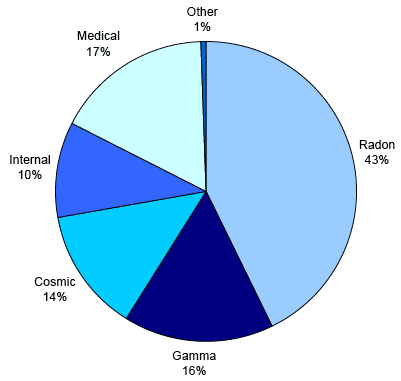Key Scottish Environment Statistics 2009
Annual publication containing summary of key statistics on environmental trends in Scotland
Radioactivity
Exposure of the Population to All Sources of Radiation: 2003 1
Average annual dose in Scotland, 2,400 microsieverts 2

Average annual dose (microsieverts)
Natural sources |
µSv |
Artificial sources |
µSv |
|
|---|---|---|---|---|
Radon |
1,040 |
Medical |
410 |
|
Gamma rays |
390 |
Other 3 |
||
Cosmic |
330 |
Occupational |
6 |
|
Internal (from diet) |
250 |
Fallout |
6 |
|
Disposals |
0.9 |
|||
Consumer products |
0.1 |
|||
The average annual dose of radiation to someone living in Scotland is 2,400 microsieverts, 83% of which comes from natural sources. The main source of natural radiation exposure is radon, a radioactive gas that is emitted from tiny amounts of uranium naturally present in materials such as rocks, soils, bricks and concrete.
Radon decays and emits short-lived products that can increase the risk of lung cancer. The action level for radon in the home is 200 Bq/m 3, above which, measures should be taken to reduce concentrations. Other important natural sources of radiation are cosmic rays, terrestrial gamma rays and long-lived radionuclides that enter the body through food and drink.
The greatest artificial source of exposure to radiation comes from medical x-rays. Nuclear waste disposals and fall-out account for less than 0.3% of exposure. The Chernobyl reactor incident in 1986 caused average annual doses from fall-out to increase by about five times that year.
Source: Health Protection Agency - Radiation Protection Division
There is a problem
Thanks for your feedback